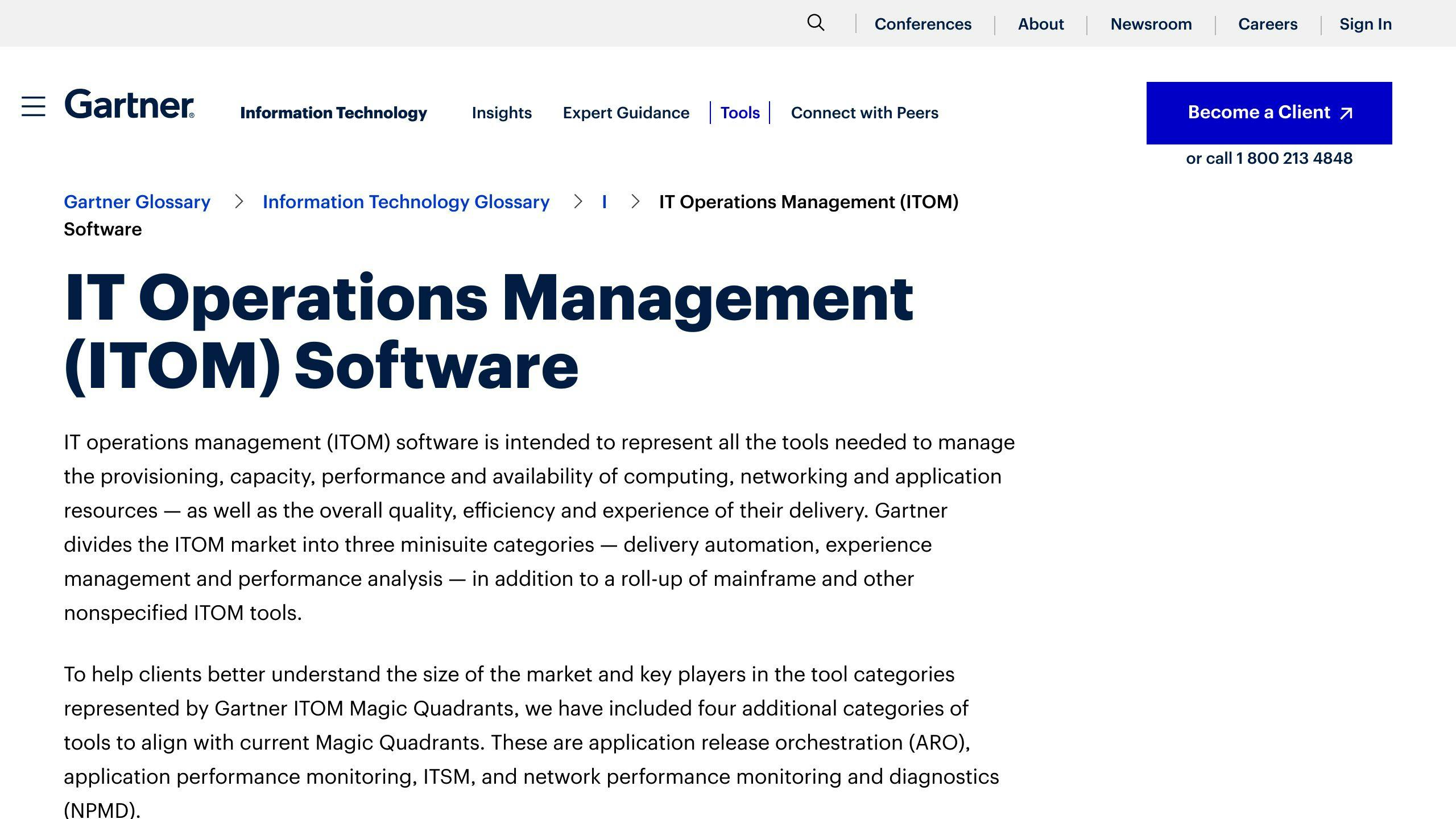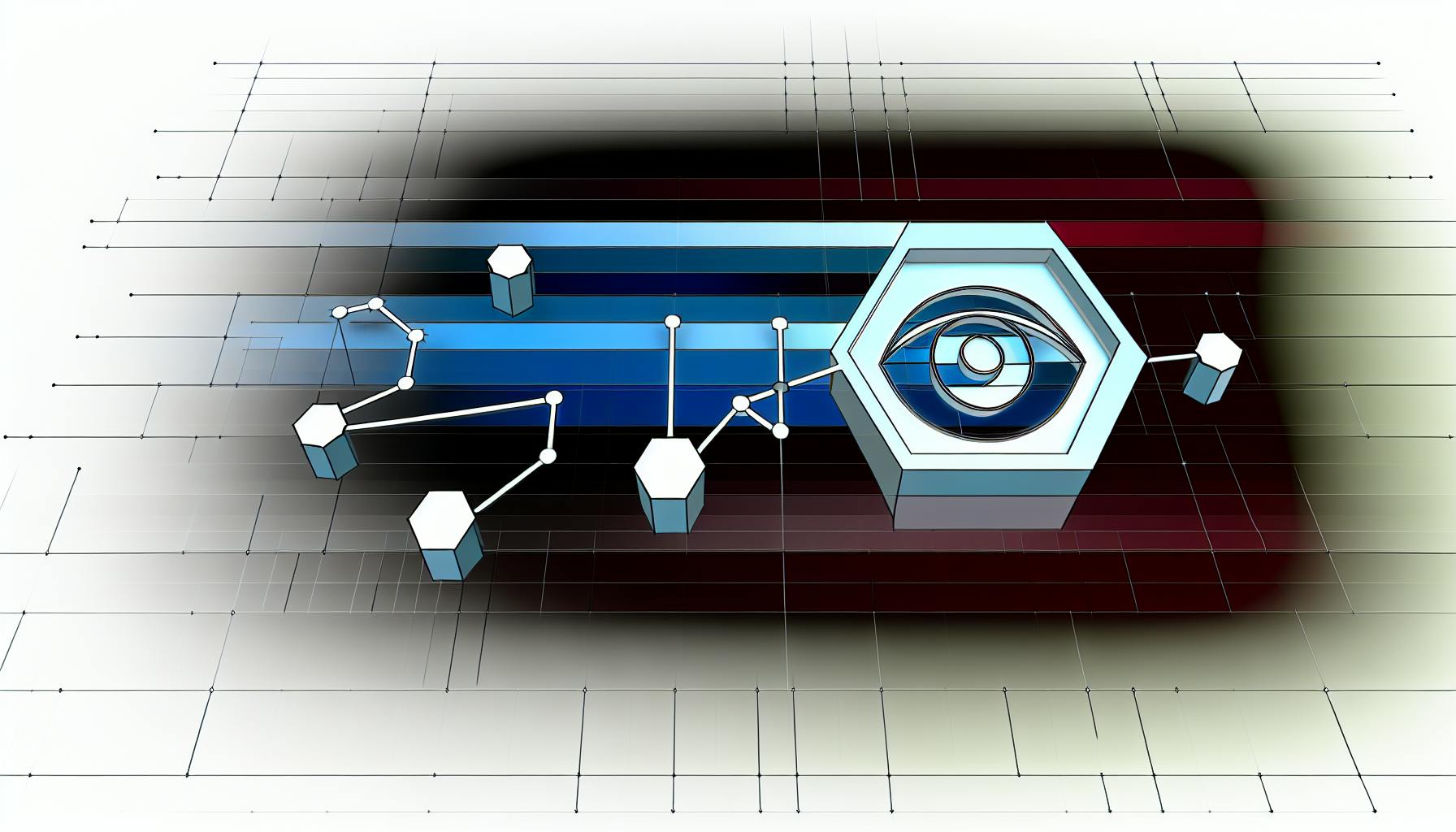In today's fast-paced tech landscape, IT Operations Management Solutions (ITOM) play a crucial role in ensuring businesses run smoothly. These solutions are all about using smart tech like AI and automation to monitor, manage, and improve your company's IT infrastructure. Here's a quick rundown of what ITOM can do for you:
- Monitor your IT infrastructure to ensure everything is running as it should.
- Analyze logs and data to spot and preemptively solve problems.
- Manage incidents efficiently, minimizing downtime.
- Forecast future needs to optimize capacity planning.
- Enhance security by detecting vulnerabilities early.
- Automate routine tasks to free up your IT team for more strategic projects.
By integrating ITOM solutions, businesses can not only prevent problems before they start but also improve efficiency, security, and ultimately save money. This guide covers everything from the basics of ITOM, its critical capabilities, how to implement these solutions, and overcoming common challenges, to ensure your tech infrastructure supports your business goals.
Components of IT Operations
The main parts of IT operations include:
- Hardware: This is the physical tech stuff like servers, storage devices, networking gear, computers, and mobile devices. They're the backbone that supports all the business systems and services.
- Software: These are the programs running on the IT setup, like operating systems, databases, applications, and security software.
- Networks: These are the connections, like LANs and WANs, that let devices and systems talk to each other.
- Data Centers: The places that hold all the computer systems, servers, and other IT gear. They're the physical home for a company's tech assets.
- Teams: The people, like IT operators, system admins, and security analysts, who set up, watch, fix, and support the tech.
- Processes: The standard ways of handling events, changes, problems, and new stuff across the tech setup.
Key Objectives and Responsibilities
What IT operations management aims to do:
- Keep services running smoothly and stop problems before they start by keeping an eye on systems.
- Use resources wisely to save money and improve efficiency by making sure everything's set up right and using automation.
- Keep everything secure by managing who can access what, keeping an eye out for threats, and staying on top of vulnerabilities.
- Make sure the business can keep going even when bad stuff happens, by having backups and disaster recovery plans in place.
- Make sure employees have a good experience by providing tech services that work well and let them do their jobs without hiccups.
- Handle changes carefully so they don't mess up the business.
- Keep improving services and systems to meet new business needs and make the most of new tech.
In simple terms, ITOM is about managing complex tech setups to make sure they're secure, work well, and add value to the business.
Critical Capabilities of ITOM Solutions
IT operations management (ITOM) solutions are essential for organizations to keep an eye on and improve their IT setup and services. Let's look at two main features that make modern ITOM solutions so helpful:
Monitoring and Analytics
Good ITOM solutions can watch over everything in an organization's IT system in real-time. This includes keeping tabs on:
- Servers
- Applications
- Networks
- Cloud services
- Devices used by employees
They then use smart analytics on this data to understand how well the IT infrastructure and services are doing. Important analytics that ITOM solutions provide include:
- Anomaly detection - Finding unusual activity that might mean a problem is coming.
- Root cause analysis - Figuring out the main reason for issues.
- Capacity forecasting - Guessing future needs based on how things are used now.
- Log analysis - Learning from the records that machines keep.
With detailed monitoring and smart analytics, ITOM solutions can spot potential issues and their main causes early, preventing big problems or slowdowns.
Automation and AI
Top ITOM tools use automation and artificial intelligence (AI) to make IT tasks simpler and create systems that can fix themselves. Examples include:
- Event correlation - Linking related events automatically.
- Intelligent remediation - Fixing common IT problems on their own.
- Predictive maintenance - Knowing about hardware failures before they happen.
- Dynamic resource allocation - Changing resources as needed without manual help.
By adding automation and AI, ITOM solutions become more efficient by cutting down on routine tasks and allowing the infrastructure to self-repair. This frees up IT teams to work on more important projects.
Implementing ITOM Solutions
Setting up IT operations management (ITOM) solutions the right way is key. It means making sure the solution fits what your business needs and works well with the systems you already have. Here's how to do it step by step.
Assessing Needs and Defining Goals
Start by taking a close look at your current IT setup. You need to:
- List out all your tech gear, software, and how things are done.
- Look at records of tech issues, times when things stopped working, and what slows things down.
- Figure out where problems usually happen and what causes them.
- Ask people who use your tech how it's going for them.
- Think about how much tech stuff you'll need in the future and how to keep it safe.
After you've gathered all this info, you can set clear goals for your ITOM, like:
- Making sure systems crash 30% less in the next 6 months.
- Getting better at fixing problems quickly, aiming for under 2 hours.
- Being able to guess how much tech capacity you'll need accurately.
Comparing Solutions and Tools
Now that you know what you need, look at different tools to find the best fit. Consider things like:
Features
- Can it monitor, analyze, and fix things automatically?
- Will it work with the tech you already use?
- Can you tweak it to fit your specific needs?
Ease of use
- Is it simple to understand and use?
- Can you easily get reports and see what's going on?
- How good is their help and training?
Scalability & reliability
- Can it handle all your data?
- Does it have a backup plan if something goes wrong?
Security
- Does it keep data safe and meet legal standards?
Total cost of ownership
- How much does it cost at first and over time?
Pick a few options that match what you're looking for and try them out before deciding. This way, you can make sure you're getting something that helps your business without wasting time or money.
sbb-itb-4a5db88
Overcoming ITOM Challenges
Setting up IT operations management solutions can be tricky. You might run into problems like not everyone being on board, not having the right skills, or having too many tools that don't work well together. But, if you plan ahead and manage changes well, you can get past these hurdles.
Winning Over Leadership with a Strong Business Case
Getting the bosses to agree is super important for ITOM to work. To convince them, focus on how it will save money and make things more efficient:
- Improved efficiency - Explain how using automation to do routine tasks can free up the IT team to do more important stuff. Guess how much time and money this could save.
- Lower costs - Show how using data to only use what you need can cut costs.
- Reduced revenue losses from IT downtime - Estimate how much money you can save by avoiding tech problems and fixing things faster. Show how this can keep money flowing in.
Use data, research, and examples from the tool sellers to make your case strong.
Training and Change Management
Making sure everyone knows how to use the ITOM solutions is crucial. Here are some tips:
- Hands-on training - Mix talking about how things work with actually trying them out to help people learn better.
- Embedded support - During the start, have a way for users to get help right from the tool, like a chat.
- Internal champions - Pick some people who are really into the new system to help spread the word and help others.
- Celebrate wins - Keep track of the good stuff that happens early on and share it to keep everyone excited.
By putting in the effort early to help everyone get comfortable and see the benefits, you can smooth out the bumps in moving to ITOM.
Conclusion and Key Takeaways
IT operations management (ITOM) solutions are super important for companies that want their tech to work better, save money, and be ready for the future. We've talked about how these solutions use smart tech like AI and automation, along with keeping a close eye on everything, to make sure tech stuff runs smoothly.
Here are the main points we covered:
- ITOM solutions help IT teams by giving them early warnings about tech problems, which means they can fix things before they become big issues. This stops them from always having to rush to fix things and lets them focus on more important projects.
- Features like fixing tech issues on their own and smartly figuring out what's wrong cut down on boring tasks. This saves money and lets IT people work on other things.
- By always knowing how the tech is doing, ITOM makes sure everything keeps running without any breaks. This means work doesn't have to stop because of tech problems.
- ITOM can predict how much tech stuff a company needs, so they don't spend too much or too little. This means spending money more wisely.
- With tools to quickly spot and deal with security threats, ITOM keeps important tech safe. This lowers the chances of big problems happening.
- When planning ITOM stuff, it's smart to talk to different people in the company to make sure the tech helps the business. This gets everyone on board and helps get the money needed.
- While setting up ITOM, it's a good idea to teach people how to use it and have some tech-savvy folks help others get used to it. This makes sure everyone uses it well and gets the most out of it.
With the right approach and help, the big changes that come with using AI in IT operations management can really pay off. Being ready for the future and having an edge over competitors because of better-running tech is worth the effort. By tackling the challenge, IT leaders can lead the way in making things more efficient, keeping work going without interruptions, and coming up with new ideas.
Related Questions
What is the role of IT operations management?

The role of IT operations management is all about making sure the tech stuff in a company runs smoothly and without problems. This includes:
- Keeping an eye on networks, servers, apps, and other tech bits to make sure they're working well and spotting any issues early.
- Making sure there's enough tech power so everything runs fast and without delays.
- Using automation to make IT services quicker and more reliable.
- Handling incidents and changes without causing disruptions.
- Making sure plans are in place for emergencies so the business can keep running.
- Protecting tech systems and data from hackers and other security threats.
- Creating reports to help make things better over time.
Basically, IT operations management is there to make sure tech services are always on and running well so the business can do its thing without any tech hiccups.
What is operations management in IT industry?
Operations management in the IT industry is about managing and improving the tech systems and setup in a company. It covers things like:
- Managing servers, networks, and cloud stuff.
- Looking after devices and software.
- Taking care of IT services like help desks.
- Keeping tech safe and meeting rules.
- Planning for emergencies.
The goal is to keep tech systems in top shape, solve problems fast, manage costs, and adjust tech as business needs change. It's super important for making sure a business can use its tech to help customers and employees.
What is operations management solutions?
Operations management solutions are tools and software that help businesses run smoother. They're all about making things like inventory, supply chains, production, and maintenance easier to handle.
These tools give you the latest info, automate boring tasks, make sure rules are followed, and help make smart decisions. By using these solutions, companies can work more efficiently, save money, avoid risks, and keep getting better at what they do.
What are the IT operations principles?
Here are some basic rules that help IT operations work well:
Automation - Making computers do the repetitive tasks to save time and avoid mistakes.
Monitoring - Always watching tech systems to catch and fix problems quickly.
Scalability - Making sure tech can grow or shrink as needed without big hassles.
Security - Keeping everything safe from hackers and leaks.
Collaboration - Getting different teams to work together smoothly.
Continuity planning - Having backups and plans ready so work doesn't stop when something goes wrong.
Knowledge management - Writing down how things are done so new people can pick up easily.
Following these rules helps IT teams keep tech running smoothly, which is great for everyone in the company.



